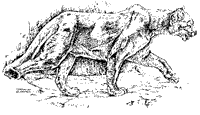| Mountain Lion | Mountain Lion Overview | Mountain Lion Damage Assessment | Mountain Lion Damage Management | Mountain Lion Acknowledgements | Mountain Lion Resources | ICWDM | Wildlife Species Information |
Contents |
Damage Prevention and Control Methods
Exclusion
Heavy woven-wire fencing at least 10 feet (3 m) high is required to discourage lions. Overhead fencing is also necessary for permanent and predictable protection. Fencing is practical only for high-value livestock and poultry. Night fencing under lights or in sealed buildings is useful where practical.
Electric fencing with alternating hot and ground wires can effectively exclude mountain lions. Wires should be 10 feet (3 m) high, spaced 4 inches (10 cm) apart, and charged with at least 5,000 volts.
Cultural Methods
Mountain lions prefer to hunt and stay where escape cover is close by. Removal of brush and trees within 1/4 mile (0.4 km) of buildings and livestock concentrations may result in reduced predation.
Chronic mountain lion predation has led to some ranchers shifting from sheep to cattle production. In areas with high levels of predation, some ranchers have changed from cow-calf to steer operations.
Frightening
Bright lights, flashing white lights, blaring music, barking dogs, and changes in the placement of scarecrow objects in livestock depredation areas may temporarily repel mountain lions. The Electronic Guard, a strobe light/siren device developed by USDA-Wildlife Services, may also deter lions.
No chemical repellents are registered for mountain lions.
No chemical toxicants are registered for mountain lion control. Since lions prefer to eat their own kills and fresh untainted meats, an efficient delivery system for toxicants has not been developed.
No chemical fumigants are registered for use on lions.
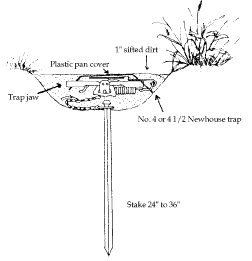
Leg hold Traps. Mountain lions are extremely strong and require very strong traps. Well-bedded Newhouse traps in size No. 4 or 4 1/2 are recommended (Fig 3). Recommended sets are shown in figures 3 and 4. Use large No. 9 wire attachment to large heavy drags, sturdy stakes, or substantial trees, posts, or rocks to anchor traps to ensure against escape. Mountain lions are easily trapped along habitual travel ways, in areas of depredations, and at kill sites. Although blind sets are usually made in narrow paths frequented by lions, baits made of fish products, poultry, porcupine, rabbits, or deer parts, as well as curiosity lures like catnip, oil of rhodium, and house cat urine and gland materials are effective attractants. Mountain lions are very curious and respond to hanging and moving flags of skin, feathers, or bright objects.
Figure 4. Trap set at mountain lion kill. Figure 5. Lion catnip set. Figure 6. Lion-trail leg-snare set.
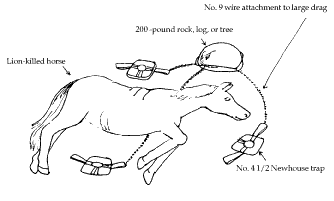
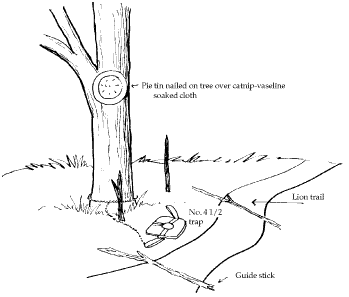
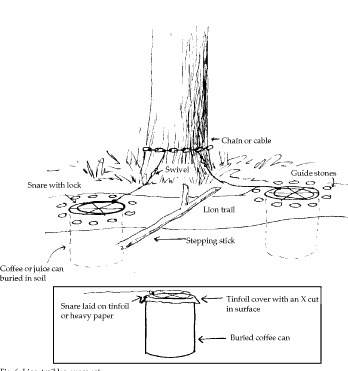
Leg snares are effective when set as described in the Black Bears chapter, and as shown here in figures 4, 5, and 6. Substitute leg snares for the No. 4 or 4 1/2 leg hold traps. The Aldrich-type foot snare can be used to catch mountain lions. This set is made on trails frequented by lions; stones or sticks are used to direct foot placement over the triggering device.
Figure 7. Kill snare set. Figure 8. Rock cubby snare set. Figure 9. Woven-wire pen set (snare).
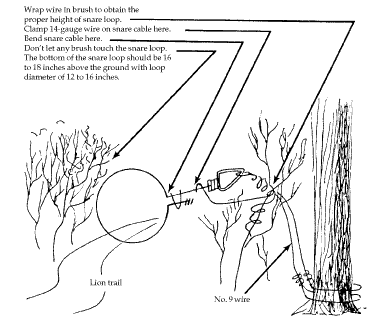
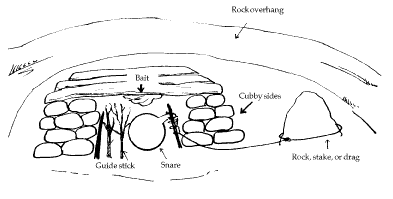
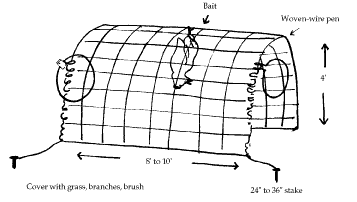
Snares can be set to kill mountain lions or hold them alive for tranquilization. Commercially made mountain lion snares are available from Gregerson Manufacturing (see Supplies and Materials). They should be suspended in lion runways and trails (Fig. 7), or set with baits in cubby arrangements (Figs. 8 and 9).
Kill snares should be placed with the bottom of the loop approximately 16 inches (40 cm) above the ground with a loop diameter of 12 to 16 inches (30 to 41 cm). Snares intended to capture lions alive should be placed with the bottom of the loop 14 inches (36 cm) from the ground and a loop diameter of 18 to 20 inches (46 to 51 cm). Snares set for live capture should be checked daily from a distance.
Large, portable cage traps are used by USDA-APHIS-Wildlife Services personnel in California to capture mountain lions that kill pets and livestock in suburban areas and on small rural holdings. The traps are constructed of 4-foot (120-cm) wide, 4-foot (120-cm) high, 10-foot (3-m) long welded-wire stock panels with 2 x 4-inch (5 x 10-cm) grid. The trap is placed where the mountain lion left the kill, and it is baited with the remains of the kill. See Shuler (1992) for details on this method.
Mountain lions sometimes return to a fresh kill to feed and can be shot from ambush when they do so. Locate an ambush site where the shooter cannot be seen and the wind carries the shooter’s odor away from the direction that the cat will use to approach the kill site. Set up at least 50 yards (45 m) from the kill site. Calibers from .222 Remington and larger are recommended. Mountain lions can be called into shooting range with predator calls, particularly sounds that simulate the distress cry of a doe deer. See Blair (1981) for additional information on calling lions.
Trained dogs can be used to capture or kill depredating lions. The dogs are most often released at the kill site, where they pick up the lion’s scent and track the lion until it is cornered or climbs a tree. The lion can then be shot and removed, or tranquilized and transplanted at least 300 miles (480 km) away. Transplanting of lions is not recommended unless they are moved to an area where no present lion population exists, where habitat and weather are similar to those of the original area, and where there will be no problem of potential depredation by the translocated lions.
Placing a mountain lion in an area with which it is unfamiliar reduces its chance of survival and is likely to disrupt the social hierarchy that exists there. Lions from a distant area may transmit a disease or contaminate a gene pool that has been maintained through a natural selection process for population survival in a specific area. In addition, depredating lions are likely to cause depredation problems in the area to which they are transplanted.
Hunting of mountain lions as big game animals should be encouraged in areas of predation to lower the competition for native food sources. To reduce or eliminate future losses, quick action should be taken as soon as predation is discovered.
In Nevada, it was estimated that annual losses of range sheep to mountain lions averaged only 0.29% (Shuminski 1982). These losses, however, were not evenly distributed among ranchers. Fifty-nine sheep (mostly lambs) were killed in one incidence. The mountain lion involved apparently killed 112 sheep in the area before it was captured.
In states such as Colorado and Wyoming, where damages are paid for lion predation, contact the state wildlife agency for information about the claims process and paperwork. Most systems require immediate reporting and verification of losses before payments are made.
| Mountain Lion | Mountain Lion Overview | Mountain Lion Damage Assessment | Mountain Lion Damage Management | Mountain Lion Acknowledgements | Mountain Lion Resources | ICWDM | Wildlife Species Information |

